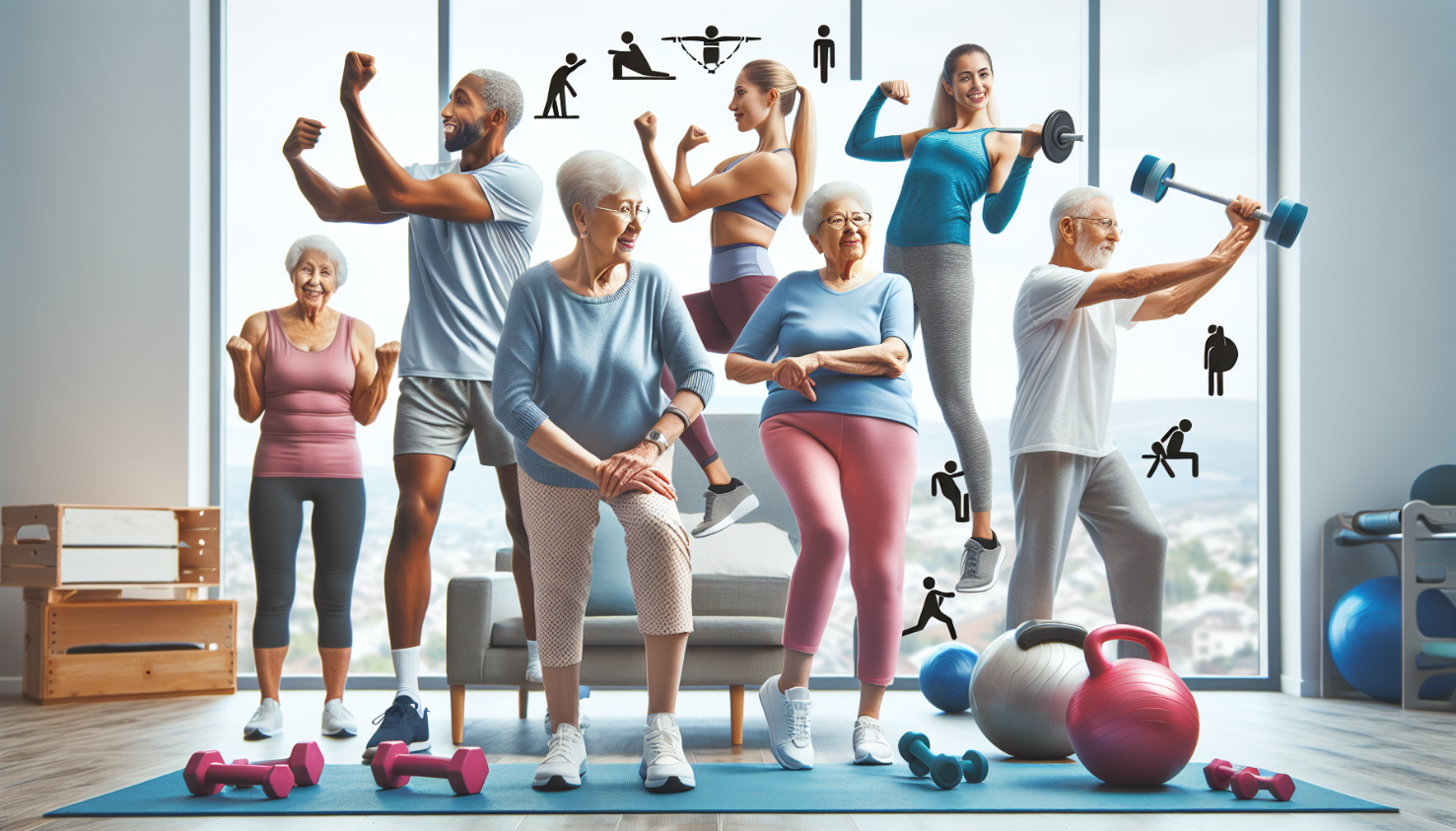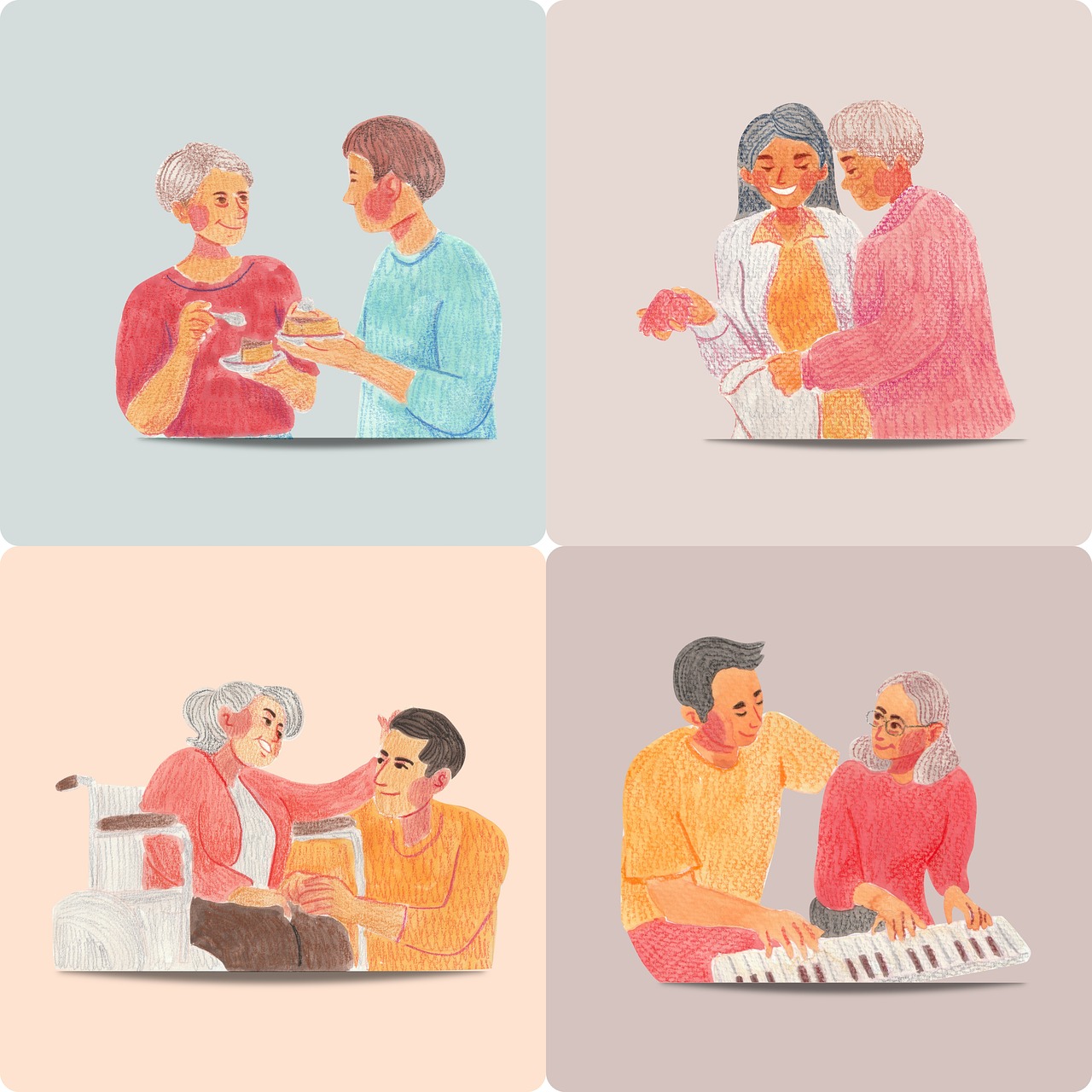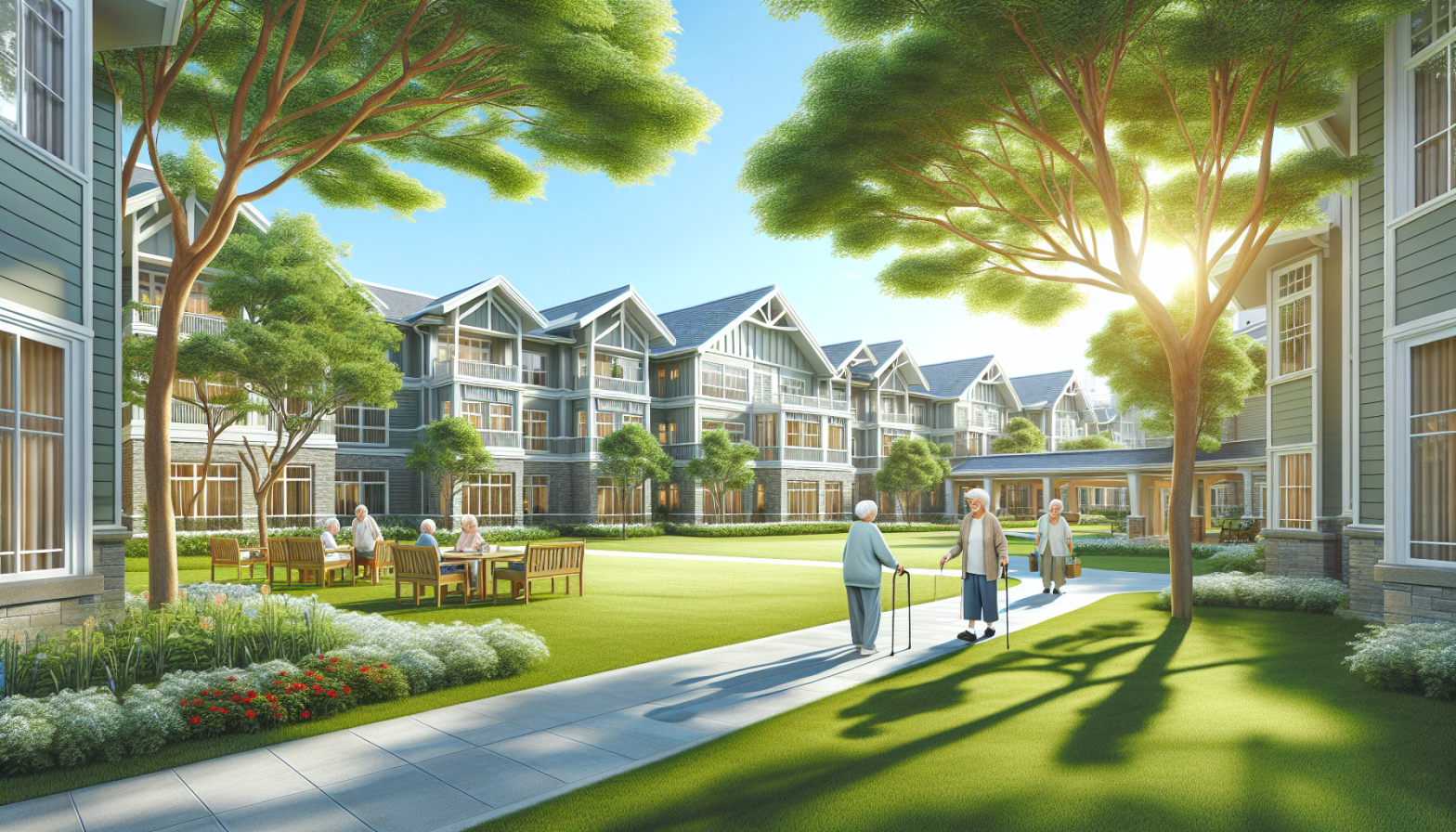Speak to a local care advisor at Assisted Living Locators by calling (888)-267-4741.
Learn about Assisted Living, Senior Living, Memory Care, and In-home care options.
Maintaining physical fitness is crucial at any age, but it becomes even more essential as individuals enter their golden years. An appropriate exercise program for seniors can significantly enhance their quality of life, promoting mobility, independence, and wellness. This crucial aspect of senior health care supports the management of common age-related issues such as arthritis, joint pain, and reduced flexibility, proving that it’s not only possible but vital to stay fit after fifty. The importance of incorporating regular physical activity into one’s daily routine cannot be overstated, given its profound benefits on physical and mental health.
This article delves into the essence of creating and maintaining an effective exercise program for seniors, highlighting the best types of workouts that cater to their unique needs. Readers will be introduced to a variety of low-impact exercises including swimming, yoga, pilates, and walking, which are tailored to improve strength, flexibility, and balance, while minimizing the risk of injury. Additionally, the article will offer sample exercise programs that blend strength training, resistance band workouts, and other activities designed to aid in managing or preventing arthritis and enhancing overall mobility. Safety tips, strategies for staying motivated, and the indispensable value of integrating these exercises for sustained wellness and independence will be thoroughly explored, guiding seniors towards a healthier, more active lifestyle.
The Importance of Exercise for Seniors
Physical activity (PA) serves as a cornerstone for maintaining and enhancing the health and well-being of seniors. It acts as a protective shield against numerous noncommunicable diseases such as cardiovascular disease, stroke, diabetes, and certain cancers. Moreover, it plays a crucial role in mental health enhancement, delaying the onset of dementia, and elevating the overall quality of life and well-being.
Protective Factor Against Diseases
Regular engagement in physical activities is directly associated with a decreased risk of developing several key health issues. The benefits of maintaining a higher level and greater frequency of PA include, but are not limited to, improved cardiovascular health, reduced risk of stroke and diabetes, and a lower incidence of certain types of cancer. This protective factor extends beyond physical health, contributing significantly to mental and emotional well-being.
Enhancing Mental and Emotional Health
The impact of regular physical activity on mental, emotional, psychological, and social well-being cannot be overstated. It fosters improvements in cognitive function and has been linked to a reduction in symptoms of anxiety and depression. The production of endorphins, often referred to as the “feel-good” hormones, through exercise, acts as a natural stress reliever, promoting happiness and satisfaction.
Contribution to Quality of Life and Independence
For seniors, the incorporation of exercise into daily routines is instrumental in maintaining their quality of life, health, and physical function. It significantly reduces the risk of falls, a common concern among the elderly, by improving strength, flexibility, balance, and coordination. Notably, exercise programs that include challenging balance activities for more than three hours per week have shown to reduce falls by 21%.
Cardiovascular and Bone Health
Exercise training in older individuals is associated with numerous health benefits, including decreased cardiovascular mortality. It induces changes in cardiac autonomic balance, leading to an increase in the vagal component, which is beneficial for heart health. Additionally, regular physical activity prevents bone loss, counteracts density reduction, and can restore bone strength, thus reducing the risk of fractures and aiding in balance.
Arthritis and Chronic Disease Management
Engaging in regular physical activity can alleviate the pain and stiffness associated with osteoarthritis by strengthening the muscles surrounding the joints and improving joint lubrication. Exercise also offers a protective effect against a host of chronic illnesses, including obesity, hypertension, and cognitive decline, underscoring its significance in managing existing conditions and enhancing overall immunity.
Immune Function and Mood Improvement
Moderate exercise has been linked to a lower incidence of acute respiratory illness and fewer sick days, showcasing its role in boosting immunity. The exact mechanisms through which exercise supports immune function are still being explored, but its anti-inflammatory effects are believed to be key contributors. Furthermore, the mood-boosting benefits of physical activity, which continue well into old age, highlight the importance of staying active for mental health.
In summary, the importance of exercise for seniors encompasses a wide range of health benefits, from disease prevention and management to the enhancement of mental and emotional well-being. Through regular physical activity, older adults can enjoy improved quality of life, greater independence, and a positive outlook on their golden years.
Health Benefits of Regular Exercise
Regular physical activity is a cornerstone for maintaining a vibrant and healthy life, especially as we age. The benefits of engaging in regular exercise extend far beyond the immediate effects of improving physical appearance or enhancing athletic performance. For seniors, an exercise program tailored to their needs can significantly impact various aspects of their health and well-being, promoting a life of independence and vitality. The following segments delve into the multifaceted health benefits that regular exercise offers to older adults.
Maintaining Independence
One of the most cherished aspects of aging is the ability to live independently. Regular physical activity plays a pivotal role in preserving this independence. By incorporating a variety of exercises into daily routines, seniors can maintain and even improve their strength, flexibility, and balance. These improvements are crucial for performing everyday activities, from carrying groceries to climbing stairs without assistance. A study by George Washington University highlighted that seniors who lead an active lifestyle are more likely to retain their mobility compared to those who spend excessive time in sedentary activities.
Improving Balance and Coordination
As individuals age, the risk of falls increases, partly due to a natural decline in balance and coordination. Regular exercise, particularly activities that focus on strengthening the legs and core, can significantly reduce this risk. Programs that include balance exercises, such as tai chi or yoga, have been shown to improve seniors’ ability to maintain their balance, thereby decreasing the likelihood of falls and the severe injuries they can cause.
Boosting Energy Levels
Engaging in physical activities can have an invigorating effect on energy levels. Exercises that combine breath and movement, like yoga and tai chi, not only enhance physical endurance but also contribute to improved mood and vitality. This boost in energy is essential for older adults, enabling them to engage more fully in daily activities and enjoy a more active lifestyle.
Preventing and Managing Chronic Diseases
The role of regular exercise in preventing and managing chronic diseases is well-documented. Physical activity helps in controlling weight, strengthening the heart, and improving blood circulation, which in turn can reduce the risk of diseases such as stroke, diabetes, osteoporosis, and heart disease. For individuals already living with chronic conditions, an appropriate exercise regimen can aid in managing symptoms and improving overall health outcomes. This preventive aspect underscores the importance of incorporating physical activity into the daily routines of seniors.
Enhancing Brain Health
Physical exercise is not only beneficial for the body but also for the mind. Research indicates that regular physical activity can promote cognitive brain health, counteracting the effects of cognitive aging. By engaging in exercises that total at least 52 hours over a period, older adults can experience improvements in processing speed, attention, executive function, and global cognition. These cognitive benefits are crucial for maintaining mental sharpness and may even reduce the risk of dementia and cognitive decline.
In summary, the health benefits of regular exercise for seniors are comprehensive, touching on every aspect of physical and mental well-being. From maintaining independence and improving balance to boosting energy levels, preventing chronic diseases, and enhancing brain health, the positive outcomes of staying active are undeniable. Encouraging older adults to adopt and maintain a regular exercise program is essential for promoting a healthy, independent, and fulfilling life in their later years.
Best Types of Exercises for Seniors
Incorporating a variety of exercises into the daily routine of seniors is vital for enhancing their quality of life, promoting independence, and managing health conditions. The best exercise programs for seniors include low-impact aerobics, strength training, and flexibility and balance exercises. Each type offers unique benefits and, when combined, can provide a comprehensive workout that addresses the key areas of senior health.
Low-Impact Aerobics
Low-impact aerobics are exercises that put minimal strain on the joints and pose a low fall risk, making them ideal for seniors. These exercises include activities like water aerobics, light marching, side taps, and gentle cardio routines that can be modified to suit one’s physical capabilities. The benefits of low-impact aerobics for seniors include improved cardiovascular health, enhanced immune response, better sleep quality, and a boost in mental health. Water aerobics, in particular, is recommended for its ability to build strength and cardiovascular fitness without overexerting the joints.
- Starting with a Light March: Begin with your feet slightly apart, engaging your core and keeping your spine long and shoulders relaxed. Gently bring your feet up, one at a time, in a marching motion. This warms up the body and prepares it for more activity.
- Side and Back Taps: Gradually introduce side taps, moving one foot to the side and then the other, followed by back taps with a little tricep kickback. These movements help to engage different muscle groups and improve coordination.
- Incorporating Movement: For those who are able, adding movement such as walking forward and back or side steps increases the intensity slightly while still maintaining a low impact on the joints.
Strength Training
Strength training is crucial for combating age-related muscle loss, maintaining bone strength, and enhancing mobility. It can also help prevent falls, fight depression, and slow cognitive decline. Seniors new to strength training should start with bodyweight exercises to learn proper form and build a foundational level of strength. Progression to light dumbbells and resistance bands can then follow, focusing on major muscle groups through functional movements that mimic everyday activities.
- Bodyweight Exercises: Begin with squats, wall push-ups, and seated resistance band rows to build strength without equipment.
- Progression to Weights: Once comfortable with bodyweight exercises, seniors can introduce light dumbbells for exercises like bicep curls and shoulder presses, gradually increasing the weight as their strength improves.
- Frequency: Engaging in strength training at least twice a week on non-consecutive days is recommended, with aerobic exercises on alternate days to maintain overall fitness.
Flexibility and Balance Exercises
Maintaining flexibility and balance is key to preventing falls and ensuring mobility and independence in seniors. Exercises that focus on these aspects include yoga, tai chi, and specific balance exercises like single-leg stands and heel-to-toe walking. These activities not only improve physical stability but also contribute to cognitive health and quality of life.
- Yoga and Tai Chi: These practices involve slow, mindful movements that enhance flexibility, balance, and mental well-being. They are adaptable to different fitness levels and can be practiced in a group setting or at home.
- Simple Balance Exercises: Incorporating exercises such as standing on one leg, walking heel-to-toe, and seated leg lifts can significantly improve balance and coordination, reducing the risk of falls.
By integrating low-impact aerobics, strength training, and flexibility and balance exercises into their routine, seniors can enjoy a comprehensive workout that promotes overall well-being, independence, and a higher quality of life.
Sample Exercise Programs
From yoga to low-impact strength and cardio, these simple-to-follow moves will keep you motivated, yet challenged. We bring you two of Joe Wicks’ (aka the family favorite, The Body Coach) workouts for seniors + 16 more sessions that will get your joints moving, elevate your heart rate and improve flexibility and strength.
Joe Wicks’ Workout for Seniors
- Duration: 10 minutes
- Equipment: None
- Simple, gentle cardio exercises including knee raises and toe taps to get your heart rate up and your joints moving. The exercises are done for 40 seconds at a time followed by a 15-second rest.
Joe Wicks’ Chair Workout for Seniors
- Duration: 10 minutes
- Equipment: A chair and a can of food (it can be anything!)
- Gentle strength exercises including arm exercises and rotations to aid mobility and muscle tone.
Kayla Itsines’ Low-Impact Workout for Seniors
- Duration: 14 minutes
- Equipment: Yoga mat (or exercise mat)
- She’s the Aussie queen of home workouts! Kayla Itsines’ low- impact workout is perfect for seniors. A core-focused workout, you’ll work through abdominal exercises such as dead bugs, Russian twists, and mountain climbers.
Strength Workout for Seniors
- Duration: 15 minutes
- Equipment: Two small hand weights (dumbbells are great) or filled water bottles you can hold comfortably
- A functional low-impact workout to directly help with day-to-day activities.
Low-Impact Cardio Workout for Over 50s
- Duration: 15 minutes
- Equipment: None – chair optional
- A cardio workout designed to get your heart rate up and work your full body.
Home Workout for Seniors
- Duration: 17 minutes
- Equipment: A stable surface to hold onto – kitchen counter or the back of a chair
- This workout can be done in the kitchen and works on strength, mobility, and balance.
Chair Workout for Seniors and Elderly People
- Duration: 20 minutes
- Equipment: A chair
- A low-intensity routine that can be done seated or standing to work your whole body.
Yoga Flow for Seniors
- Duration: 28 minutes
- Equipment: Yoga mat
- Yoga with Adriene is famous for her accessible and simple-to-follow yoga flows. This one is just under half an hour and perfect for seniors.
Pilates for Seniors Standing Workout
- Duration: 30 minutes
- Equipment: None
- Straight from ‘The Girl with the Pilates Mat’, this session is brilliant for those suffering from general aches and pains as well as improving balance and coordination.
Chair Workout for Seniors in Gujarati and English
- Duration: 33 minutes
- Equipment: A chair
- Follow along as PT Lavina and her mother-in-law work through some senior-friendly chair exercises. Follow along with Lavina’s English or Sasu’s Gujarati instructions.
Fun, Low-Impact Workout for Seniors and Beginners
- Duration: 40 minutes
- Equipment: None
- A fun and upbeat workout designed to get you working for longer. It’s still low impact, just for an extended period of time.
Seated Exercises for Seniors
- Duration: 40 minutes
- Equipment: None with the option of ankle weights
- A series of exercises designed to show what exercises are possible sitting down.
Standing Exercises for Seniors
- Duration: 40 minutes
- Equipment: None
- A series of exercises designed to show what exercises are possible standing up.
Yoga Flow for Seniors
- Duration: 7 minutes
- Equipment: None
- Designed to build strength, improve flexibility and boost balance, this quick yoga workout for seniors is a great low-impact alternative to vigorous flows.
Indoor Walking Workout for Seniors
- Duration: 20 minutes
- Equipment: None
- Marching or walking in place is the foundation of this video, with some fun dance moves thrown in. A cardio workout, there are about 2,400 steps, encouraging you to work on your balance and coordination.
Gentle Stretching Workout for Seniors
- Duration: 17 minutes
- Equipment: None (can be done standing), but a chair is optional
- A full-body set of stretches, including your arms, wrists, legs, ankles, and shoulders. Gentle, light stretching will improve your circulation and flexibility, and relieve stress.
Full-Body Chair Stretches for Seniors
- Duration: 20 minutes
- Equipment: A chair
- Total-body, head-to-toe stretching, with relaxing music to offset stiffness and leave you more limber. You’ll be feeling lighter, looser, and rejuvenated.
Strength and Balance Workout for Seniors
- Duration: 30 minutes
- Equipment: A pair of light dumbbells
- These 10 compound exercises are osteoporosis-friendly, and suitable for active seniors and beginners. Some are bodyweight and some are weighted, ensuring things are kept challenging but still manageable.
This comprehensive collection of exercise programs for seniors is designed to cater to various fitness levels and preferences, promoting an active and healthy lifestyle for those in their golden years.
Safety Tips for Exercising
Consulting a Doctor
Before embarking on any new exercise program, seniors should consult with their healthcare provider. This is particularly crucial for those with chronic conditions such as heart disease, high blood pressure, diabetes, or any history of dizzy spells. Utilizing tools like the Physical Activity Readiness Questionnaire (PAR-Q) can help determine the necessity of a medical consultation before starting or increasing the intensity of an exercise regimen.
Starting Slowly
It’s essential to begin any new exercise routine gradually. Rushing into strenuous activity can lead to injuries and discouragement. Seniors should start with low-intensity exercises and slowly build up their endurance and strength. This approach helps in adapting to new routines without overwhelming the body.
Using Proper Equipment and Attire
Selecting the right equipment and attire is vital for safe and effective workouts. Shoes should be comfortable, with good support and non-skid soles to prevent falls. Clothing should be appropriate for the type of exercise and the weather conditions, allowing for free movement and proper ventilation. Regularly replacing worn-out shoes and opting for attire that fits well and supports the body can significantly reduce the risk of injuries and enhance the exercise experience.
Staying Hydrated and Listening to Your Body
Hydration plays a critical role in overall health, especially during physical activities. Seniors are advised to drink water before, during, and after exercise to prevent dehydration, which can lead to serious health issues. It’s also important to listen to the body’s signals. If any exercise causes pain, or if symptoms like dizziness, shortness of breath, or chest pain occur, it’s crucial to stop the activity immediately and consult a healthcare provider. Adjusting the exercise routine based on personal health conditions and comfort levels is essential for maintaining safety and effectiveness in a fitness program.
Staying Motivated
Maintaining motivation is crucial for seniors to adhere to an exercise program that enhances their quality of life. This section explores effective strategies to keep seniors engaged and committed to their fitness routines.
Setting Realistic Goals
Setting achievable goals is the foundation of a successful exercise regimen. Seniors should begin by assessing their current physical condition with the assistance of a healthcare provider. This ensures that the goals set are not only realistic but also safe. Writing down these goals helps to solidify them, creating a clear roadmap for success. Goals should be split into short-term and long-term categories:
- Short-term Goals: These might include finding an exercise partner or scheduling regular workout sessions, which help integrate physical activity into daily life.
- Long-term Goals: These could range from improving cardiovascular health to enhancing mobility to play with grandchildren. The key is to choose objectives that bring personal satisfaction and health improvements.
Regularly revisiting and adjusting these goals ensures they remain aligned with one’s abilities and life changes.
Tracking Progress
Keeping a detailed journal or log of daily activities and progress can significantly boost motivation. Tools such as activity trackers or simple notebooks can be used to track the frequency and type of exercises performed. This not only helps in recognizing the progress made but also in identifying when adjustments might be necessary. The following methods are recommended for effective progress tracking:
- Activity Logs: Document daily exercise routines and any physical responses noted during or after the session.
- Progress Tests: Periodically record results from simple fitness tests to visually track improvements in physical capabilities over time.
- Adjustment Notes: Make note of any changes in the exercise plan, focusing on what works best for maintaining regular activity.
Finding a Workout Buddy or Group
Exercising with others can greatly enhance motivation through shared experiences and accountability. Seniors are encouraged to join groups or find exercise partners who share similar fitness goals. This not only makes the workouts more enjoyable but also fosters a supportive community. Here are some ways to integrate social interactions into exercise routines:
- Join Local Fitness Groups: Many community centers offer group classes that cater to senior fitness levels.
- SilverSneakers Programs: These programs provide a great way to meet peers and engage in tailored exercise routines.
- Online Forums and Local Events: Utilizing online resources to find walking or exercise buddies can expand social networks and commitment to regular activity.
By setting realistic goals, tracking progress, and incorporating social elements into exercise routines, seniors can sustain motivation and enjoy the numerous health benefits of regular physical activity.
Conclusion
Through the comprehensive exploration of the importance, benefits, and types of exercises tailored for seniors, it’s clear that maintaining an active lifestyle is crucial for enhancing their quality of life, managing health conditions, and promoting independence and mobility in their golden years. The discussion reiterated that integrating a mix of low-impact aerobics, strength training, and flexibility and balance exercises, as well as adhering to recommended safety tips and motivation strategies, can lead to significant improvements in physical and mental well-being for the elderly. This holistic approach to senior fitness addresses the unique needs of older adults, ensuring they can achieve a healthier, more active lifestyle.
Encouraging seniors to adopt these exercise programs while considering their individual health conditions and preferences underlines the importance of personalized fitness plans. By fostering the motivation to stay active, emphasizing the safety of exercise routines, and highlighting the array of health benefits, this article aims to inspire seniors to embrace physical activity as a joyous, rewarding part of their daily lives. As the population ages, the relevance of such exercise programs for seniors becomes ever more significant, offering a pathway to improved health, enhanced independence, and a more fulfilling and vibrant life in the later years.
FAQs
About the Fit After 50 Program
1. Can I trust the Fit After 50 program? Yes, the Fit After 50 program is considered trustworthy. It has been specifically designed for men who are 50 years old and above, with exercises tailored to suit the needs of middle-aged individuals.
2. What does the Fit After 50 program entail? The Fit After 50 program is a comprehensive workout regime aimed at helping men over 50 enhance their testosterone levels, bone density, muscle mass, among other health aspects. It focuses on reversing the health decline commonly associated with aging.
Recommended Exercises for Seniors
3. What kind of exercise is most advantageous for older adults? Moderate-intensity aerobic activities are highly recommended for seniors. These include brisk walking, cycling, swimming, dancing, and engaging in nature walks, all of which contribute significantly to senior health.
4. What constitutes an ideal workout routine for individuals over 50? For those in their 50s, a balanced workout plan should include daily mobility exercises, aerobic cardio of low to moderate intensity 2-3 times a week for 20-40 minutes, and resistance training of low to moderate intensity 1-2 times a week for 20-30 minutes.












